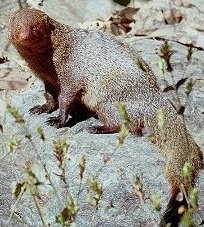
Now that the water is quickly receding on the lakebed, the emphasis is changing from the aquatic to the land animal. In the dry season the reservoir area is replete with rabbits, foxes, snakes and mongoose. But with the excessive flooding this year, a lot of animals had to migrate from their burrows and seek safety on higher ground.
So it was with great satisfaction that a very nice Indian Mongoose crossed our path during our walk early this morning. My dogs were so startled by the intrepid and never-before-seen critter, that they were immobilised whilst it made a very easy escape into some thick undergrowth.
The Indian grey mongoose is found throughout India and prefers areas of bush and tall grass. The Indian grey mongoose, which is also known as the common grey mongoose, is generally a grizzled grey or tawny in colour, with a lighter underside, darker feet, and dark red tail tip. They have a reddish tint to their head. Their tail length equals their body length. Males are significantly larger than the females.
Among the better-known mongooses are those of the genus Herpestes, which range from southern Europe into Africa and southern Asia. The Indian gray mongoose, H. Edwardsi, which may reach 50cm (20in) long plus a 41cm (16in) tail, and weigh about 2.3kg (5lb), is the one portrayed in Kipling's Jungle Book.
This mongoose feeds on mice, rats, lizards, and snakes, but will eat some fruit. They have been known to attack domestic poultry. They are popular for killing poisonous snakes, which they kill with speed and agility. The Indian grey mongoose is diurnal. They are found in fields and open forests, often close to humans. They live in burrows, which can be anything from a hedgerow to rock crevices and drains. They are usually solitary or sometimes in pairs.
No comments:
Post a Comment